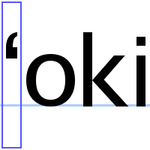| ʻOkina letter forms | |
|---|---|
 | The Hawaiian ʻokina or Tongan fakauʻa (Unicode U+02BB[1]), as it appears in the Lucida Sans font. |
 | The Tahitian ʻeta or Wallisian fakamoga (currently not encoded separately), as it appears in the Lucida Sans font. |
 ʻŌlelo Hawaiʻi (Hawaiian: Hawaiian language) within single quotes, font: Linux Libertine. The glyph of the two ʻokinas is clearly different from the glyph of the opening quote. | |
The ʻokina (Hawaiian pronunciation: [ʔoˈkinɐ]), also called by several other names, is a consonant letter used within the Latin script to mark the phonemic glottal stop in many Polynesian languages. It does not have distinct uppercase and lowercase forms.
Names
| Language | Vernacular name | Literal meaning | Notes |
|---|---|---|---|
| Hawaiian | ʻokina | Separator; cutting; breaking | Transitionally formalized.[clarification needed] The ʻokina has historically been represented in computer publications by the grave accent (`), the left single quotation mark (‘), or the apostrophe ('), especially when the correct typographical mark (ʻ) is not available. |
| Samoan | koma liliu | "Inverted comma"—inverted (liliu) comma (koma) | Often replaced by an apostrophe in modern publications, recognized by Samoan scholars and the wider community.[2] Use of the apostrophe and macron diacritics in Samoan words was readopted by the Ministry of Education in 2012 after having been abandoned in the 1960s.[3] |
| Tahitian | ʻeta | ʻetaʻeta = to harden | No official or traditional status; may use ' or ‘ or ’ |
| Tongan | fakauʻa (honorific for fakamonga) | Throat maker | Officially formalized |
| Cook Islands Māori | ʻamata or ʻakairo ʻamata | "hamza" or "hamza mark" | No official or traditional status; may use ' or ‘ or ’ or nothing |
| Wallisian | fakamoga | By throat | No official or traditional status; may use ' or ‘ or ’ |
Appearance
The ʻokina visually resembles a left single quotation mark (‘)—a small "6"-shaped mark above the baseline.
The Tahitian ʻeta has a distinct shape, like an ʻokina turned 90° or more clockwise.[citation needed]
Orthography and official status
The ʻokina is treated as a separate letter in the Hawaiian alphabet. It is unicameral—that is, it does not have separate uppercase (capital or majuscule) and lowercase (small or minuscule) forms—unlike the other letters, all of which are basic Latin letters. For words that begin with an ʻokina, capitalization rules affect the next letter instead: for instance, at the beginning of a sentence, the name of the letter is written "ʻOkina", with a capital O.
Geographic names in the United States
The United States Board on Geographic Names lists relevant place names both with and without the ʻokina and kahakō (macron) in the Geographic Names Information System. Colloquially and formally, the forms have long been used interchangeably.[4]
Computer encoding
Apostrophes and quotation marks
In the ASCII character set, the ʻokina is typically represented by the apostrophe character ('), ASCII value 39 in decimal and 27 in hexadecimal. This character is typically rendered as a straight typewriter apostrophe, lacking the curve of the ʻokina proper. In some fonts, the ASCII apostrophe is rendered as a right single quotation mark, which is an even less satisfactory glyph for the ʻokina—essentially a 180° rotation of the correct shape.
Many other character sets expanded on the overloaded ASCII apostrophe, providing distinct characters for the left and right single quotation marks. The left single quotation mark has been used as an acceptable approximation to the ʻokina, though it still has problems: the ʻokina is a letter, not a punctuation mark, which may cause incorrect behaviour in automated text processing. Additionally, the left single quotation mark is represented in some typefaces by a mirrored "9" glyph, rather than a "6", which is unsuitable for the ʻokina.
Unicode
In the Unicode standard, the ʻokina is encoded as U+02BB ʻ MODIFIER LETTER TURNED COMMA, which can be rendered in HTML by the entity ʻ (or in hexadecimal form ʻ).[1]
Although this letter was introduced in Unicode 1.1 (1993), lack of support for this character prevented easy and universal use for many years. As of 2008[update], OS X, Microsoft Windows and Linux-based computers and all new major smartphones have no problem with the glyph, and it is no longer a problem in Internet Explorer 7 as it was in previous versions. U+02BB should be the value used in encoding new data when the expected use of the data permits.
Other glottal stop characters, such as U+02C0 ˀ MODIFIER LETTER GLOTTAL STOP, are inappropriate for the ʻokina. The glottal stop letter in Tahitian and Wallisian has a distinct appearance, like the turned comma rotated 90° clockwise.[citation needed] This glyph is not currently assigned a separate character in Unicode. The currently implemented Unicode character that most closely resembles the ʻeta or fakamoga symbol is U+1D54 ᵔ MODIFIER LETTER SMALL TOP HALF O.
See also
References
External links
- Apple compatibility with Hawaiian added in OS 10.2
- Apple Computer Includes Hawaiian Language Support With Latest Operating System. Archived 2006-09-11 at the Wayback Machine
- Honolulu Advertiser (September 2, 2002): I mua! Macintosh 'speaks' Hawaiian
- Starbulletin (September 16, 2002): Macs upgrade to isle punctuation Archived May 20, 2007, at the Wayback Machine
- SFGate (September 9, 2002): Hawaiian language advocates applaud new Mac operating system.
- Honolulu Advertiser (June 28, 2004): Hawaiian spellings catch on, but slowly. (On slow progress in using proper Hawaiian spellings instead of makeshift English spelling.)
- Ulukau: The Hawaiian Electronic Library: Browser information for viewing Hawaiian characters Archived 2006-12-05 at the Wayback Machine
- The Okina in French Polynesian, a graphic example on the top of the page of the official website of the commune of Faa'a, capital of the French Polynesia (this explains why the INSEE still encodes it like the French apostrophe).
- Polynesian Font hints and information on encoding.